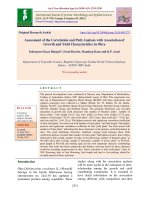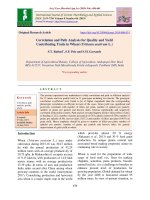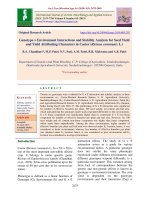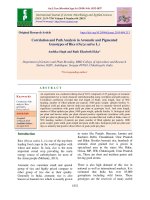Estimation of genetic variability, correlation and path analysis for seed yield characters in chickpea (Cicer arietinum L.)
Bạn đang xem bản rút gọn của tài liệu. Xem và tải ngay bản đầy đủ của tài liệu tại đây (212.7 KB, 7 trang )
Int.J.Curr.Microbiol.App.Sci (2019) 8(3): 2355-2361
International Journal of Current Microbiology and Applied Sciences
ISSN: 2319-7706 Volume 8 Number 03 (2019)
Journal homepage:
Original Research Article
/>
Estimation of Genetic Variability, Correlation and Path Analysis for Seed
Yield Characters in Chickpea (Cicer arietinum L.)
O. Manikanteswara*, G. Roopa Lavanya, Y.H. Ranganatha and
M. Manikanta Sai Chandu
Department of Genetics and Plant Breeding, Naini Agricultural Institutute, Sam Higginbottom
University of Agriculture Technology and Sciences, Allahabad - 211007, Uttar Pradesh, India
*Corresponding author
ABSTRACT
Keywords
Genetic variability,
Heritability, Genetic
advance, Correlation,
Path analysis
Article Info
Accepted:
20 February 2019
Available Online:
10 March 2019
The experimental material comprised of 21 chickpea genotypes and the experiment was
laid out in Randomised Complete Block Design with three replications, during rabi, 2017
Maximum GCV and PCV were recorded for seed yield per plant and harvest index. High
genetic advance as percent of mean recorded for seed yield per plant. Seed yield per plant
showed high positive significant correlation with harvest index and pods per plant at
phenotypic and genotypic levels. Biological yield and Harvest index exhibited high direct
positive effect on seed yield per plant at phenotypic and genotypic levels. Genotypes
C138, C108, C201 and C1021 of chickpea were found to be superior for seed yield per
plant.
Introduction
The word Cicer is a derivative from the Greek
word kiros referring to a well-known Roman
family Cicero. Arietinum is derived from the
Latin word arise meaning ram which refers to
the ram’s head shape of the chickpea (Singh,
1985). Chickpea is an important Rabi season
legume having extensive geographical
distribution. Chickpea plays an important role
to improve soil fertility by fixing atmospheric
nitrogen with the help of root nodules
(Anabessa et al., 2006). Genetic variability
refers to the presence of difference among the
individual of plant population the existing
variability is essential for improvement of
genetic material (Nimbalkar et al., 2000).
However, it is only genetic variation which is
heritable and hence important in any selection
programme. Correlation coefficient gives an
ideal about the various associations existing
between yield components. As yield is a
complex character direct selection for this
character as such becomes a difficult task
without knowledge of relationship between
yield and its various components. The path
analysis model has two types of effects. The
first is the direct effect and the second is the
indirect effect. When the exogenous variable
has an arrow directed towards the dependent
variable, then it is said to be the direct effect.
When an exogenous variable has an effect on
2355
Int.J.Curr.Microbiol.App.Sci (2019) 8(3): 2355-2361
the dependent variable, through the other
exogenous variable, we have to add the direct
and indirect effect. One variable may not have
a direct effect, but it may have an indirect
effect as well (Statistics solutions).
Research gap
India remains a net importer of Chickpea
Despite contributing to more than 60% to
global Chickpea area and production. This
phenomenon is due to high national demand.
To meet the demands of increasing
population, there is need to develop high
yielding varieties. Therefore it is need to use
genetic variability, correlation, and path
analysis as a tool in crop improvement
programme
The present investigations were therefore
undertaken to study the genetic variability,
correlation and path analysis in chickpea with
the following objectives.
To estimate the extent of variability for yield
and contributing characters in Chickpea
To study the association between different
characters
To find out direct and indirect effects of
component characters on yield in chickpea
Materials and Methods
The present investigation was carried out at
the Field Experimentation Centre, Department
of Genetics and Plant Breeding, Naini
Agricultural Institute, Sam Higginbottom
University of Agriculture, Technology and
Sciences, Allahabad, U.P. (India) during Rabi2017. The experimental materials consist of
21 genotypes obtained from Dept. of GPB,
SHUATS. The experiment was laid out in
Randomized Complete Block Design with
three replications. The genotypes were sown
by hand dibbling in each plot by imposing
randomization in each replication along with
check Uday. The spacing of row to row 30cm
and plant to plant 10cm was maintained. The
fertilizer dose of 20:40:40 NPK kg/ha is
applied as Nitrogen as two splits, phosphorus
and potassium as basal dose. All
recommended package of practices were
followed during the cropping period to raise a
good crop. Observations were recorded in
each plot and replication by taking five plants
randomly for nine quantitative characters viz.
Mean data for nine characters viz., days to
50% flowering, days to maturity, plant height,
number of primary branches per plant, number
of pod per plant, biological yield, harvest
index, seed index and seed yield per plant. The
data was subjected to the statistical analysis
the correlation coefficients and are estimated
as suggested by Al Jibouri et al., (1958), path
coefficient analysis (Dewey and Lu, 1959).
Results and Discussion
The analysis of variance revealed highly
significant to significant differences among
the genotypes for all the nine characters
studied (Table 1). In the present study
variation among the characters are estimated
by Genotypic Coefficient of Variation (GCV)
and Phenotypic Coefficient of Variation
(PCV). The PCV was slightly higher than the
GCV for few characters indicates the
interaction of genotypes with the environment
(Table 2). High GCV and PCV were recorded
for seed yield per plant (21.27 and 21.27)
followed by harvest index (19.51 and 20.60).
Estimates of heritability are a good index for
predicting the transmission of characters from
parents to their offspring (Falconer, 1981).
High heritability (broad sense) was recorded
for characters i.e., seed index and days to
maturity (97 %) followed by pods per plant
(92 %). The genotypic and phenotypic
correlation coefficient and path analysis were
computed among 9 characters (Table 3).
2356
Int.J.Curr.Microbiol.App.Sci (2019) 8(3): 2355-2361
Table.1 Estimates the Genetic parameters for nine quantitative characters in chickpea genotypes
S. No.
Characters
Range
Grand
Mean
Genotypic
Coefficient
of variance
(GCV)
Phenotypic
Coefficient
of variance
(PCV)
Heritabilit
y
(broad
sense)
(%)
Genetic
Advance
as
percent
mean
Minimum
Maximum
69.00
82.00
74.95
4.44
5.68
86
8.50
104.66
127.66
113.79
5.59
5.68
97
11.31
33.80
62.93
48.73
15.05
16.00
88
29.14
2.20
3.13
2.67
7.20
13.61
28
7.85
22.46
47.40
32.83
18.08
18.82
92
35.79
Biological
yield
Harvest index
%
15.38
31.36
22.38
17.22
19.00
82
32.16
38.65
80.64
58.52
19.51
20.60
90
38.07
8
Seed index
15.00
25.76
20.23
15.59
15.79
97
31.71
9
Seed
yield/plant
10.54
20.60
13.03
21.27
21.27
86
40.70
1
2
3
4
5
6
7
Days to 50 %
flowering
Days to
maturity
Plant height
Number of
primary
branches
Pods/plant
2357
Int.J.Curr.Microbiol.App.Sci (2019) 8(3): 2355-2361
Table.2 Estimation of Genotypic and Phenotypic correlation coefficients between yield characters of chickpea
Characters
Days to 50%
flowering
Days to
maturity
Plant height
Primary
branches
/plant
Pods/ plant
Biological
yield
Harvest
index
Seed index
G
P
G
P
G
P
G
P
G
P
G
Days to
maturity
Plant
height
Primary
Pods/
branches/p plant
lant
Biological
yield
Harvest
index
Seed
index
Seed
yield/
plant
0.994**
0.904**
1.000
1.000
0.136
0.078
0.055
0.072
1.000
1.000
0.189*
-0.008
0.137
0.118
-0.060
-0.036
1.000
0.012
0.035
-0.023
-0.010
-0.127
-0.116
-0.067
0.058
0.031
0.022
0.020
0.331**
0.259**
-0.761**
0.173
0.162
0.137
0.115
-0.350**
-0.299**
0.605**
0.080
0.072
0.002
0.005
-0.077
-0.072
0.305**
0.222*
0.185*
0.133
0.113
-0.019
-0.018
-0.099
1.000
-0.039
1.000
-0.217*
0.505**
0.205*
0.116
0.166
-0.361**
0.011
0.568**
1.000
0.457**
1.000
0.116
-0.367**
-0.345**
-0.143
0.525**
0.542**
1.000
-0.371**
1.000
-0.108
0.567**
0.538**
0.565**
1.000
0.528**
1.000
0.548**
0.405**
1.000
0.385**
P
G
P
G
P
G=Genotypic correlation coefficient P= Phenotypic correlation coefficient. *Significant at 5% level, **Significant at 1% level.
2358
Int.J.Curr.Microbiol.App.Sci (2019) 8(3): 2355-2361
Table.3 Estimation of genotypic and phenotypic path analysis between yield characters of chickpea
Characters
Days to
maturity
Plant
height
Primary
Pods/
branches/p plant
lant
Biologic
al yield
Harvest
index
Seed
index
Seed
yield/
plant
G -1.655
-1.646
-0.225
-0.313
-0.020
-0.097
-0.286
-0.133
0.222
P 0.114
G 1.547
0.103
1.555
0.009
0.085
-0.001
0.213
0.004
-0.036
0.003
0.035
0.018
0.213
0.008
0.003
0.185
0.133
P
G
P
G
-0.102
-0.004
0.002
0.088
-0.007
-0.087
0.028
-0.039
-0.012
0.005
-0.001
0.645
0.001
0.011
-0.003
-0.043
-0.002
-0.028
0.007
-0.492
-0.011
0.030
-0.007
0.391
-0.0005
-0.008
-0.008
0.197
0.133
-0.019
-0.018
-0.099
P -0.0002
G -0.001
0.003
0.003
-0.001
0.019
0.026
0.010
-0.001
-0.155
-0.005
-0.078
0.005
-0.018
0.004
0.056
0.011
0.568
P 0.003
G 0.087
-0.001
0.034
-0.011
0.493
-0.003
-1.132
0.098
0.751
0.045
1.486
0.011
-0.546
-0.034
-0.213
0.525
0.542
Harvest index
P 0.024
G 0.123
0.016
0.102
0.205
-0.261
-0.172
0.450
0.361
0.086
0.790
-0.273
-0.293
0.744
-0.085
0.422
0.538
0.565
Seed index
P 0.127
G 0.005
0.090
0.0002
-0.235
-0.005
0.161
0.020
0.091
-0.023
-0.291
-0.009
0.784
0.037
0.414
0.065
0.548
0.405
P 0.005
0.0004
-0.005
0.013
-0.027
-0.008
0.042
0.080
0.385
Days to 50%
flowering
Days to
maturity
Plant height
Primary
branches
/plant
Pods/ plant
Biological
yield
Days to
50%
flowering
-0.092
-0.011
0.002
0.122
G = Genotypic path analysis, P = Phenotypic path analysis
2359
Int.J.Curr.Microbiol.App.Sci (2019) 8(3): 2355-2361
Seed yield per plant had showed high positive
significant correlation with harvest index and
pods per plant at phenotypic and genotypic
levels. Biological yield and days to maturity
exhibited high direct positive effect on seed
yield per plant at phenotypic and genotypic
levels. Genotypes C138, C108, C201 and
C1021 of Chickpea was found to be superior
for seed yield per plant.
By considering the nature and extent of
correlation coefficients and path analysis it
can be concluded that improvement of
Chickpea seed yield is brought through
simultaneous selection of harvest index, pods
per plant, biological yield and days to
maturity.
The results from present study concluded
among 21 genotypes C138, C108, C201 and
C1021 of chickpea were found to be superior
for seed yield per plant. High GCV and PCV
observed for seed yield per plant and harvest
index. High heritability coupled with high
genetic advance as percent of mean was
registered for number of pods per plant.
Hence these parameters could be used for
selection. Seed yield per plant shows high
positive significant association with harvest
index, biological yield, pods per plant at
phenotypic, genotypic levels. Biological
yield, harvest index exhibited high positive
direct effect on seed yield at phenotypic and
genotypic levels. Thus, priority should be
given to these characters during selection for
yield improvement in chickpea.
References
Ali, M, Mishra, Singh and Kumar (2011).
Exploitation of genetic variability for
grain yield improvement in chickpea.
International Journal of Agriculture
and Biology, 4(1): 149-152.
Bhatia, D.S. and Rathore, S. Singh. (1993)
Effect of seed soaking treatment with
agrochemicals on germination and
seedling attributes of chickpea. Madras
Agricultural. Journal, 73: 378-380.
Chauhan, M.P. and Singh, I.S. (2000).
Variability estimates and identifying
chickpea genotypes for yield and yield
attributes in salt affected soil. Legume
Research, 23(3): 199-200.
Dewey. R.D. and Lu, K.H. (1959). A
correlation and path coefficient analysis
of components of crested wheat grass
seed
production.
Journal
of
Agronomy.51: 515- 518.
Eswari, K.B. and Rao, M.V.B. (2006).
Phenotypic stability for seed yield in
Bengal gram. Journal Research,
Acharya
Nagarjuna
Agriculture
University, 34(1): 101-104.
Farshadfar, M. and Farshadfar, E. (2008).
Genetic variability and path analysis of
chickpea (Cicer arietinum) landraces
and lines.Journal Application Sciences,
8: 3951-3956.
Indu Bala Dehal, Kalia, R. and Kumar, B.
(2016). Genetic estimates and path
coefficient analysis in chickpea (Cicer
arietinum L.) under normal and late
sown environments. Legume Research,
39(4):510-516.
Jeena, A. S. Arora, P.P. and Ojha (2005)
Variability and correlation studied for
yield and its components in chickpea.
Legume Research, 28 (2):146-148.
Singh, S.P., (2007). Correlation and path coefficient analysis in chickpea (Cicer
arietinum L.). International. Journal.
Plant Science, 2: 1–4.
Thakur, S.K. and Sirohi, Anil. (2008). Studies
on genetic variability, heritability and
genetic advance in chickpea under
different environments. International
Journal of Agriculture Science, 4(1):
242-245.
Wanjari, K.B., Patil, A.J. and Chawghawe,
P.B. (1996). Genetic variability in F5
progenies
derived
from
bulk
2360
Int.J.Curr.Microbiol.App.Sci (2019) 8(3): 2355-2361
populations in chickpea. Annual of
Pluses Physiology, 10(1): 83-86.
Yucel, D.O. Anlersal, A.E. and Yucel, C.
(2006). Genetic variability, correlation
and path analysis of yield and yield
components in chickpea. Turkish
Journal of Agriculture and Forestry,
30(3): 183-188.
How to cite this article:
Manikanteswara, O., G. Roopa Lavanya, Y.H. Ranganatha and Manikanta Sai Chandu, M.
2019. Estimation of Genetic Variability, Correlation and Path Analysis for Seed Yield
Characters in Chickpea (Cicer arietinum L.). Int.J.Curr.Microbiol.App.Sci. 8(03): 2355-2361.
doi: />
2361






![Studies on correlation and path analysis for grain yield and quality components in foxtail millet [Setaria italica (L.) Beauv.]](https://media.store123doc.com/images/document/2020_01/09/medium_dyd1578574836.jpg)


